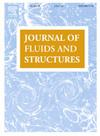开放生长树木的空气动力导纳和动力学
IF 3.5
2区 工程技术
Q1 ENGINEERING, MECHANICAL
引用次数: 0
摘要
加强我们对树木在风荷载下的结构响应的理解是很重要的,因为了解它们的空气动力学行为对于在极端风条件下对树木损伤进行现实的风险评估是必要的。在这里,我们首先提出了一个气动导纳函数的解析模型,该模型将风在单点处的湍流波动与其在冠锋面区域的空间平均值联系起来。后者负责风在树干底部引起的弯矩。我们采用空气动力学导纳函数来模拟开放式橡树的动力结构响应。分析沿两个轴进行,以表示相对于平均风向的纵向和横向响应。所得到的预测结果与在阀杆下部采用的应变计观测结果进行了比较。所提出的框架表明,相对于树幅方向,树冠锋面区域的空间平均对树在顺流风向上的运动有更强的影响。此外,气动阻尼在顺流方向上也更强,通常与入流风速呈正相关。本文章由计算机程序翻译,如有差异,请以英文原文为准。
Aerodynamic admittance and dynamics of an open-grown tree
Enhancing our understanding of the structural response of trees exposed to wind loading is important, since the knowledge of their aerodynamic behaviour is necessary for a realistic risk assessment of tree damage during extreme wind conditions. Here, we first present an analytical model of the aerodynamic admittance function that relates the turbulence fluctuations of the wind at a single point to their spatial average over the crown’s frontal area. The latter is responsible for the wind-induced bending moments at the base of a tree’s stem. We employ the aerodynamic admittance function to model the dynamic structural response of an open-grown oak tree. The analysis is performed along two axes to express both the longitudinal and transverse response with respect to the mean wind direction. The resulting predictions are compared with strain gauge observations taken at the lower part of the stem. The presented framework shows that the spatial averaging over the crown’s frontal area has a stronger effect on the tree’s movements in the streamwise wind direction compared to the spanwise direction. Further, the aerodynamic damping is also stronger in the streamwise direction and generally correlates positively with the inflow wind speed.
求助全文
通过发布文献求助,成功后即可免费获取论文全文。
去求助
来源期刊

Journal of Fluids and Structures
工程技术-工程:机械
CiteScore
6.90
自引率
8.30%
发文量
173
审稿时长
65 days
期刊介绍:
The Journal of Fluids and Structures serves as a focal point and a forum for the exchange of ideas, for the many kinds of specialists and practitioners concerned with fluid–structure interactions and the dynamics of systems related thereto, in any field. One of its aims is to foster the cross–fertilization of ideas, methods and techniques in the various disciplines involved.
The journal publishes papers that present original and significant contributions on all aspects of the mechanical interactions between fluids and solids, regardless of scale.
 求助内容:
求助内容: 应助结果提醒方式:
应助结果提醒方式:


